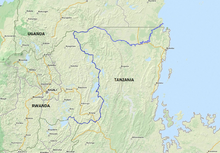Kagera River
| Kagera Akagera | |
|---|---|
Ruvubu rivers near Rusumo Falls, Rwanda/Tanzania. | |
 Map of the Kagera River flowing into Lake Victoria. | |
| Location | |
| Country | Burundi |
| Country | Rwanda |
| Country | Tanzania |
| Region | Kagera Region |
| Country | Uganda |
| Physical characteristics | |
| Source | |
| • coordinates | 2°21′18″S 30°22′22″E / 2.35500°S 30.37278°E |
| Source confluence | near Lake Tanganyika |
| • location | Eastern Province, Rwanda |
| Mouth | |
• location | Lake Victoria |
• coordinates | 0°56′41″S 31°46′36″E / 0.94472°S 31.77667°E |
| Length | 597 km (371 mi) |
| Basin size | 59,700 km2 (23,100 sq mi) |
| Discharge | |
| • average | 184 m3/s (6,500 cu ft/s) |
| • maximum | 540 m3/s (19,000 cu ft/s) |
| Basin features | |
| Tributaries | |
| • left | Ruvuvu River |
The Kagera River, also known as Akagera River, or Alexandra Nile, is an East African river, forming part of the upper headwaters of the Nile and carrying water from its most distant source.[1]: 167 With a total length of 597 km (371 mi) from its source located in Lake Rweru in Rwanda.
The section of river named Kagera begins in
The river has featured prominently in the histories of the countries it runs through, particularly Rwanda. In 1894, German Gustav Adolf von Götzen crossed the Kagera at Rusumo Falls, marking the Rwandan colonial era that officially started in 1899. And in 1916, during World War I, the Belgians defeated the Germans, entering Rwanda by the same route. The river gained international notoriety in 1994 for carrying bodies from the Rwandan genocide into Lake Victoria, causing a state of emergency to be declared in areas of Uganda, where these bodies eventually washed up.
Geography
The Kagera rises in Burundi and flows into Lake Victoria. It is the largest single
Fish
The Kagera River basin is rich in fish. As of 2001[update], there were at least 55 species known from the Rwandan section alone and the actual number is likely higher.
Genocide
During the Rwandan genocide of 1994, the Kagera was used to dispose of corpses as thousands of Tutsis and Hutu political moderates were murdered on the river banks.[8] The river brought the massacred bodies into Lake Victoria, creating a serious health hazard in Uganda.[9]
See also
- Ruvuvu River- Right tributary of the river
- Nyabarongo River - Left tributary of the river
References
Notes
- ISBN 0486256677
- ^ "Archived copy" (PDF). Archived (PDF) from the original on 2016-03-04. Retrieved 2019-09-21.
{{cite web}}: CS1 maint: archived copy as title (link) - ^ Rangeley, p. 54
- ^ Dumont, p. 341
- ^ .
- ISBN 9782831718965.
- S2CID 153931262.
- ^ January, p. 83
- ^ Lorch, Donatella (21 May 1994), "Thousands of Rwanda Dead Wash Down to Lake Victoria", The New York Times, archived from the original on 17 March 2013, retrieved 26 February 2010
Sources
- Dumont, Henri J. (2009). The Nile: Origin, Environments, Limnology and Human Use. Springer. ISBN 978-1-4020-9725-6.
- January, Brendan (2007). Genocide: modern crimes against humanity. Twenty-First Century Books. p. 83. ISBN 978-0-7613-3421-7.
- Rangeley, Robert (1994). International river basin organizations in sub-Saharan Africa. ISBN 0-8213-2871-9.
External links
- . Encyclopædia Britannica (11th ed.). 1911.
